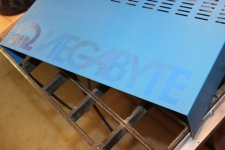Old_hitech
Experienced Member
Happy to say, I remember that song when I was little. Had not heard it in years. Thanks.
If it was early 1960's then I was in high school or just out. Doesn't that make us OLD?
Anyway, today, I finished the key pads and got them installed. After testing the keyboard I have at least 3 questionable keys. I also have an occasional problem with the shift key or keys? I'm not going to reopen the keyboard until I run the machine for a few days to further test the keyboard.
I cleaned up my drive box and connected to the SOL. Geezzz.... I have forgotten how to make this machine work. I'm going to have to read the manuals again. The CONSOLE program seems to work and I can start DOS, I get a sign notice of "NORTH STAR DOS 5.2S" Here I can display memory do a LI (DIR) of each disk. I can even load a SOL System Monitor 5.2 and do a couple of functions. So, the next item for attention is to re read the manuals and continue to test what I have. Then later, maybe in a week see if I can repair the remaining keys, once I have a more complete list. Thanks for the help. I may have additional questions of how this machine works, Last time I used any programs on this was in the middle 1980's. Because of the fact that I can't seem to remember what I had for breakfast, I don't find that out of line. Mike

Happy to say, I remember that song when I was little. Had not heard it in years. Thanks.
So far there seems to be about a half dozen keys that exhibit some extra action. They all seem to be unrelated. A couple will act up all the time and the others will only occasionally show a double character. I still want to wait until I re open the keyboard until I know precisely which keys are troublesome.
Back to the key board. I read Hugo's document and started in on the keyboard. I found the clock to be OK and the outputs of the column drivers 7442 to be OK. Next I looked at the output pin 3 of the CD4051, the analog MUX. The good keys would show a high (+5) and a short low pulse about 1 mSec apart. A bad key (the top 2 in this case) would most always print the 2 followed by a lot of junk. Looking at Pin 3 of the 4051, I would see the short low pulses at about 80 uSec apart when the junk occurred and 1 mSec when only the 2 printed. So something is wrong here, but so far I'm unsure what. I need to study the circuit a little more. Mike
